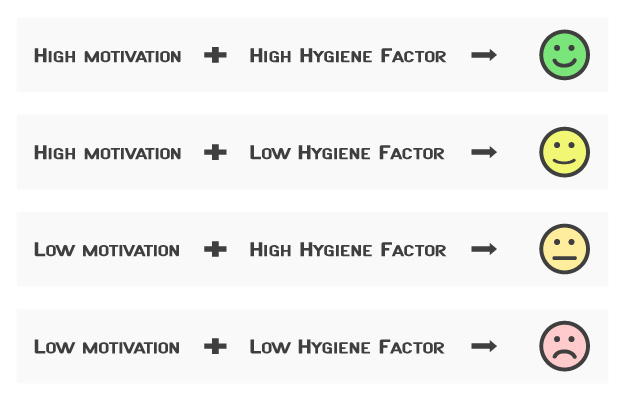Frederick Irving Herzberg was one of the most influential persons in business management. He was a psychologist from America who became renowned worldwide for introducing the Herzberg Motivation-Hygiene Theory. The theory is also known by the name Two-Factor Theory and Dual-Factor Theory.
In the theory, Herzberg has explained certain factors relating to the workplace that cause job satisfaction and dissatisfaction. Moreover, he has explained that the terms satisfaction and dissatisfaction act independently. In simple words, what the theory wants to say is –
Opposite to SATISFACTION is NO SATISFACTION
Opposite e to DISSATISFACTION is NO DISSATISFACTION
Components of the Theory
According to Herzberg, an individual’s attitude towards his job is determined two major factors. They are
- Motivation factors (factors relating to job satisfaction)
- Hygiene factors (factors relating to job dissatisfaction)
| Motivation factors | Hygiene factors |
|---|---|
| – Job itself
– Achievement – Recognition – Growth – Responsibility – Job challenges – Opportunities – Involvement in decision making |
– Policies and administrative practices
– Supervision – Relationship with superiors – Working conditions – Salary – Job security – Relationship with colleagues – Personal life – Fringe benefits |
Relationship between motivation and hygiene factors
Motivation factors such as rewards and recognition are known to enhance the enthusiasm and reason of an individual to do the task. Yet, this does not imply that individuals would not do the task in absence of these factors. On the other hand, hygiene factors such as comfortable furniture, clean restrooms, relationships with peers and superiors, etc. are not responsible to motivate people but their absence can, however, lower job satisfaction.
While motivation factors increase the feeling of satisfaction of an individual regarding the job, hygiene factors prevent the feeling of dissatisfaction to develop. A perfect balance between both these factors can help the employers in utilizing their employees to the fullest. The relationship between motivation and hygiene factors can be better understood by the following illustration.

High motivation + High hygiene = Ideal work condition; employees are highly interested to do the job and have fewer complaints
High motivation + Low hygiene = Exciting job but uninteresting working condition; employees are moderately interested to do the job and have more complaints
Low motivation + High hygiene = Job is viewed as a source of income, employees are uninterested to do the job and have fewer complaints
Low motivation + Low hygiene = Worst scenario; employees are uninterested to do the job and have more complaints
How to maintain motivation and hygiene factors at the workplace?
| Motivation factors can be maintained by | Hygiene factors can be maintained by |
|---|---|
|
|
Criticisms of the Theory
Herzberg has interestingly distinguished motivation factors with hygiene factors and has helped us in understanding the applicability of this theory. However, critics have noted some criticisms. They are
- The theory has not explained the effect of individual traits such as age, gender, qualifications, skills, social status, personality etc. on motivation and hygiene factor.
- Herzberg has not provided the value of individual motivational factor.
